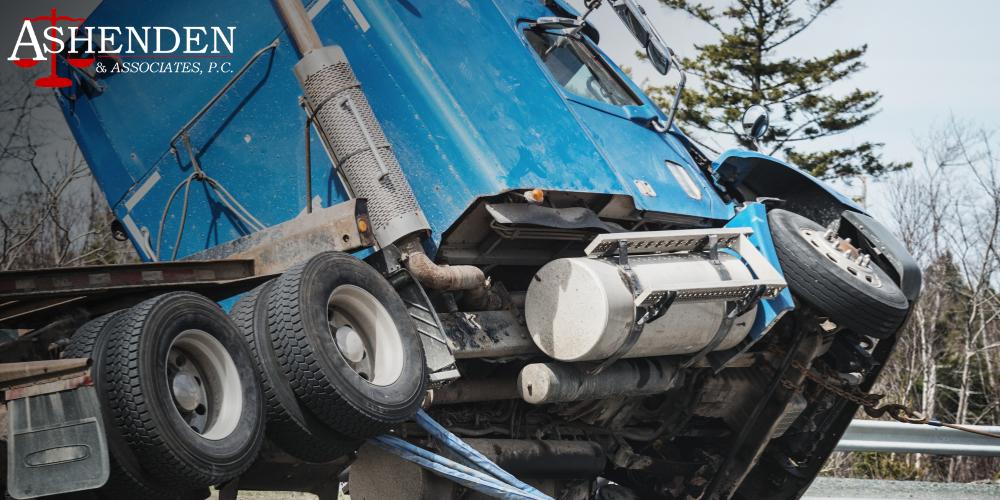
Like almost all other vehicles, semi-trucks have blind spots, which make it difficult for truck drivers to see other vehicles around their trucks. If a passenger vehicle drives in one of these semi-truck blind spots, the truck driver may stop, accelerate, or change lanes as if the other vehicle isn’t even there.
Still, drivers of semi-trucks are obligated to other drivers and must drive with reasonable caution. When they don’t, they can cause a blind spot accident and may be liable for the damages. If you or a loved one has been injured in a semi-truck accident, the Sandy Springs truck accident lawyers are here for you. Call us at 770-394-8909 to schedule a free consultation with a member of our legal team.
What Are Truck Driver “No-Zones?”
A “no-zone” is another term for a semi-truck’s blind spots. Large trucks have significant blind spots to the front, back, right, and left of the truck’s cab, which makes it difficult for the truck driver to see passenger vehicles around them. A truck driver’s failure to check a no-zone is one of the most common causes of trucking accidents.
Just like with other passenger vehicles, a semi-truck’s mirrors only show so much, so simply checking the truck’s mirrors may not be enough for a truck driver to understand where other cars are in relation to them fully. Luckily, the trucking industry is finding more ways to help truck drivers know where other cars are, like using fish eye mirrors, backup cameras, and side view assist.
1994 No-Zone Program
Due to the dangers of semi-truck blind spots, Congress ordered the Federal Highway Administration to provide the public with information on no-zones through a public awareness campaign. This no-zones program aimed to increase awareness and decrease the number of blind spot accidents nationwide.
While all motor vehicle accidents can cause severe damage, a trucking blind spot accident has a higher capacity for property damage and personal injury. By informing the public of these no-zones or blind spots, where a semi-truck driver may not be able to see other cars, the government was able to promote safe driving and potentially prevent some truck accidents from happening.

Why Do Semi-Trucks Have Large Blind Spots?
One of the biggest reasons why semi-truck drivers have such large blind spots is because they lack rearview mirrors. Since commercial trucks almost always have a large trailer behind their cab, the rearview mirror can’t show the driver the road behind them.
Additionally, semi-trucks are significantly bigger than other passenger vehicles, making it difficult for the driver to see cars on the road beside them and in front and behind them.
Truck Driver’s Blind Spot Locations
There are four major semi-truck blind spots, or no-zones, on semi-trucks, located to the right, left, rear, and front of the cab.

Right Side No-Zone
The right side no-zone can be found directly to the right side of the truck next to the driver’s side door. This truck blind spot extends backward and towards the right at an angle. Side view mirrors may not see any other vehicles beside or behind the semi-truck driver’s side door, thus not visible to the truck driver.
Left Side No-Zone
The left side no-zone is the largest since the semi-truck’s driver is furthest away from that side of the vehicle. The left side no-zone starts right behind the truck’s cab and extends backward and to the left. It can cover at least two lanes of traffic, so other vehicles must stay mindful of this when driving next to or passing a semi-truck on the left.
Rear End No-Zone
The rear-end no-zone begins right behind the truck’s trailer and extends at least 30 feet behind the truck. As a rule of thumb, if you cannot see a truck driver’s reflection in the left side mirrors, the truck driver cannot see you in his or her side mirror or rearview mirrors (if they even have a rear view option). Staying out of this rear blind spot can help avoid a blind spot accident.
Front No-Zone
Like the area directly behind the truck, there is also a large blind spot directly in front of the semi-truck where the driver cannot see. The front no-zone begins at the front of the truck’s cab and extends forward at least 20 feet. Smaller vehicles need to give truck drivers enough space when driving in front of them to avoid this blind spot and a potentially dangerous situation in case the driver must stop suddenly.

How to Drive Safely as a Passenger Vehicle
Good, defensive car drivers can help avoid car accidents. The same is true for truck accidents. Below are some tips on avoiding Sandy Springs blind spot accidents so that you and your passengers can reach your destination safely.
Avoid Truck Blind Spots
The best way to avoid a blind spot accident is to be mindful when driving near or passing semi-trucks. Staying out of trucks’ blind spots can help protect you, your passengers, and other drivers, including the truck driver, from harm.
If you have to be in blind spots, try to move out of it or through it safely and quickly. This ensures that if the truck driver begins changing lanes, you won’t be in a position where the trucker’s ability to see is minimized. They will most likely see you while you are entering or driving out of their blind spot before actually changing lanes.
Don’t Tailgate a Truck
Tailgating is a dangerous driving practice, even with other passenger vehicles. Driving directly behind a large truck can make it difficult for your vehicle to make a sudden stop if the truck slams on its brakes. Riding in that large blind spot behind the truck also creates forward blind spots for you as the driver, which can be extremely dangerous.
Safe Lane Changes in Front of a Truck
When changing lanes in front of semi-trucks or tractor-trailers, you must give the large truck enough space to see you and slow down, if necessary. If you move directly in front of a semi-truck and suddenly slam on your brakes, that truck driver may not see you at all, let alone see you slow down.
It’s important to note that truck drivers must check their blind spots and stay vigilant while driving. If you or a loved one has been injured in a semi-truck accident, you may be able to recover compensation for your losses.
A truck accident attorney at Ashenden & Associates can help evaluate your case and determine whether or not you have a claim. Call us at 770-394-8909 to schedule a free initial case evaluation with one of our Sandy Springs personal injury attorneys today.

How Truck Drivers Can Drive Safely
Many different types of trucking accidents can be avoided if truck drivers pay attention to the vehicles around them and follow traffic laws like speed limits. Below are some safety tips to help truck drivers avoid accidents and protect other cars and their cargo from damage.
Be Vigilant
Truck drivers should always be vigilant, checking blind spots to avoid accidents. If a truck driver sees that a vehicle is about to drive into their semi-truck’s blind spot, they can stay aware of the location of the car. Semi-truck drivers should also frequently check their side view mirrors, especially if they plan on changing lanes.
Use Turn Signals
Another way to avoid blind spot accidents and other kinds of accidents is by using turn signals when turning or changing lanes. This can help prevent passenger vehicles from entering a truck’s blind spot and ensure other vehicles behind them give the semi-truck enough room to merge across the two lanes or change lanes safely.
Slow Down
Truck drivers are often on the road for hours and hours, and are often under a lot of pressure to make it to their destination within a certain amount of time by the trucking companies they work for. Still, unnecessary speeding can be incredibly dangerous and risk people’s lives. Speed limits exist for a reason, and vehicles driving faster can cause exponentially more harm than other, slower vehicles.
Avoid Fatigued and Distracted Driving
Our Sandy Springs fatigued driving attorneys know that fatigue is one of the greatest dangers to all drivers, especially truck drivers. Since semi-truck drivers often drive for hours and hours on end, sometimes late into the night or early morning hours. People who drive commercial trucks should ensure they get enough sleep before driving, take breaks, and stop to rest when needed.
Truck drivers should also avoid distractions while behind the wheel. Setting up navigational devices, picking music, or eating on the road can make it difficult for someone to give their undivided attention to driving. Limiting or eliminating distractions while driving a semi-truck or tractor-trailer can significantly reduce the likelihood of an accident.

Call a Sandy Springs Truck Accident Lawyer at Ashenden & Associates Today
Truck accident lawsuits are often complex and usually involve multiple parties. If you have been injured in an accident while in a semi-truck blind spot, you should contact a truck accident attorney who can help you file a claim. You may be able to receive financial compensation from the trucking company for things like medical expenses, lost wages, emotional distress, and more.
The attorneys at Ashenden & Associates understand how reasonable truck accident settlements can help families and are dedicated to helping you stand up against big trucking companies to receive the compensation you deserve. With over 50 years of combined experience in personal injury law, you can rest easy knowing your case is in capable hands. Call us at 770-394-8909 or contact us online to schedule a free consultation with one of our attorneys.

